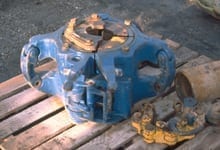
Oilfield elevators are used to wrap around the tool joint of drip pipe or casing, and to facilitate the lifting and lowering of the pipe or the drill string. Of all the components on a rig, elevators are one of the most stressed, and require regular inspection. Ideally, sets of spare elevators are often required for general operations.But, realistically, elevators aren’t always recertified as often as they should be. Due to the prevailing conditions of the offshore drilling business (as well as the difficulty of reaching offshore rigs in general), routine inspections may often be skipped. But this is a lose-lose proposition for the rig — faulty and potentially risky elevators can stop operations and cost companies millions.That’s why you need to ensure that all your offshore equipment is recertified. Recertification is not only a good idea for daily operations, but it also gives your company an easy way out via insurance in the event of an accident.
Recertifying Offshore Drilling Equipment
Of course, it’s not quite that simple. The reason many rigs tend to lapse in their recertification is because it’s a complex and often tedious process that stops operations, and which can incur hefty costs in the form of penalties and new equipment.Still, it doesn’t have to be that way. The proper habits and precautionary steps can ensure that recertification is always a simple, relatively straightforward experience with minimal costs to the company.
Step 1: Buying from API-licensed manufacturers
One surefire way to guarantee recertification is by only buying certified equipment in the first place.The American Petroleum Institute (API) licenses “Drilling and Production Hoisting Equipment” manufacturers under API Spec 8C, which covers elevator links, tubing and rill pipe elevators, sucker rod elevators, spiders (if capable of being used as elevators) and various other types of hoisting equipment. Any elevator manufacturer who wishes to have the API’s seal of approval needs to fill out this form to apply for the official monogram.The API is a globally recognized certification and licensing leader in various industries, and also has extensive experience licensing and certifying regular elevators as well. Any manufacturer with the API seal of approval is likely to have already undergone a few of the necessary certification requirements.
Step 2: Routine Inspection
But it goes without saying that an elevator that goes over the 10-year mark is probably nowhere near the same condition it was when you bought it.That’s why routine inspection is so important. All drill rig elevators should be examined on a weekly basis for cracks, dents, loose couplings or other signs of wear and tear. Any potentially damaged elevators should be swapped out with their fresh replacements before an accident occurs and brings ground operations to a halt.This simple visual inspection can end up saving your rig hundreds of thousands of dollars throughout its lifetime, and allow you to make the most of your equipment without unnecessary headaches.

